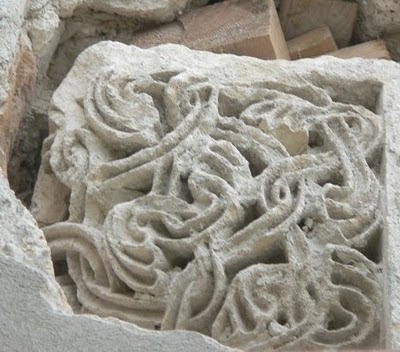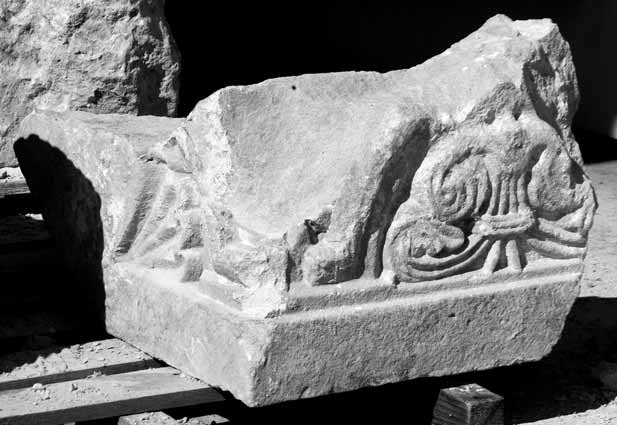Medieval History


The survey of the walls revealed that the insertion of Romanesque carved stones was not incidental, as about 80 to 90% of the Baroque masonry is built from Romanesque stones. With the exception of some brick material, used for arches and the crown of the wall, every part of the wall was built from stones of the medieval monastery. Based on the condition of these stones, it can be supposed that some of them came directly from the remains of the medieval buildings, while others come from already ruined areas, or even from the bottom of the Danube. Altogether, over 100 individual carved stones were surveyed in detail ? naturally all of these carry remains of moldings or other carved decoration. Some of them preserved traces of the original medieval painted plaster. Most spectacular are some of the bases and columns, several of which were removed from the wall. In addition to these carved stone, there are hundreds of ashlar blocks and other as of yet unidentified carvings are in the walls. Most of the stones were covered with a red plaster, and some traces of black and white painted decoration ? on two stones even more colorful painting ? were also identified. This proves what Mátyás Bél noted in the 18th century, who described the picturesque and decorated ruins of the monastery.
- Medieval Church Finds Home In California
Father Paul Mark Schwan shivers in the morning chill of California's Sacramento Valley, a blue hooded sweatshirt layered over his monk's robes. It's almost eerily quiet at the Abbey of New Clairvaux, an order of Cistercian monks in this town...
- Dozens Of Medieval Finds Reported In Scotland?s Treasure Trove
The government of Scotland has issued its annual Treasure Trove Report today, which lists the archaeological discoveries made between April 2009 and March 2010. The report notes the finds of dozens of items dating back to the Middle Ages and earlier....
- 800 Years Of Ják Abbey
Fresco of St. George at Ják, c. 1256 This weekend - the weekend after Saint George's Day - mark the 800th anniversary of the foundation of the Benedictine monastery of Ják. It is known that the monastery was established by Márton "the Great"...
- Medieval Stone Carvings Stolen From The Hungarian National Gallery
As it was revealead on Tuesday, two highly important Romanesque stone carvings had been stolen from the Hungarian National Gallery some time in early February. Both carvings were on view in the medieval lapidary of the Gallery, located on the ground floor...
- Conference About Pécs Cathedral
The medieval building of Pécs cathedral was completed during the 12th century. The building, although rebuilt several times, essentially survived until the late 19th century, when it was drastically remodeled ('restored') in Neo-Romanesque style....
Medieval History
Romanesque stone carvings from the abbey church of Ercsi

The Benedictine monastery of Ercsi was located about 40 kilometers south of Buda (present?day Budapest), on an island of the Danube next to the much larger Csepel Island. The monastery was founded by Palatine Thomas (1185-1186), who was also buried there. The monastery ceased to exist during the Ottoman conquest of central Hungary and stones of the monastery church were used as building material for the church of Szigetújfalu during the 18th century. During the past summer, the exterior of the Szigetújfalu was restored, giving a chance to examine the Romanesque carvings used as building material there, and also providing a chance to remove some of these stones. The first report on this was written by Lilla Deklava Farbaky and Balázs Bodó, and was published in the December 2010 issue of the journal Örökség (Heritage), published by the National Office of Cultural Heritage. The issue can be read online (a least by those with some knowledge of Hungarian) ? for the benefit of my other readers, I am providing an abstract of the text below.
?Topographical literature has noted before that the church of Szigetújfalu was built in 1770 using stones from the abandoned monastery of Ercsi. Géza Entz published this first in an article in 1965. During the Spring and Summer of 2010, while plaster was removed from the exterior of the church, a chance came to finally examine these stones.
Remains of the monastery are extremely important, because they are the only securely dated examples of a stylistic group encompassing the Romanesque stone carvings of Pécs, Székesfehérvár and Somogyvár. The fact that the founder, Palatine Thomas was buried in the sacristy means that at least some parts of the building were completed by 1186. The northwestern corner of the church of Szigetújfalu had been hit during WWII, and subsequently several carved stones were removed from here, which are today preserved at the King Saint Stephen Museum at Székesfehérvár. Based on the stylistic features of these stones, it had been proposed that the workshop responsible for contemporary carving from the Provostal church of the Virgin Mary at Székesfehérvár, also worked at the monastery of Ercsi.
In 2010, large surfaces of the exterior of the Szigetújfalu church were documented, and survey dravings were made of individual Romanesque stone carvings. The contractors working on replastering the church adapted to the demands of this survey. In the end it was decided that 11 of the most important carvings should be removed from the wall, and this was carried out with the support of the contractors and other donors. The authors carried out the full documentation, occasionally with the help of other colleagues.

The survey of the walls revealed that the insertion of Romanesque carved stones was not incidental, as about 80 to 90% of the Baroque masonry is built from Romanesque stones. With the exception of some brick material, used for arches and the crown of the wall, every part of the wall was built from stones of the medieval monastery. Based on the condition of these stones, it can be supposed that some of them came directly from the remains of the medieval buildings, while others come from already ruined areas, or even from the bottom of the Danube. Altogether, over 100 individual carved stones were surveyed in detail ? naturally all of these carry remains of moldings or other carved decoration. Some of them preserved traces of the original medieval painted plaster. Most spectacular are some of the bases and columns, several of which were removed from the wall. In addition to these carved stone, there are hundreds of ashlar blocks and other as of yet unidentified carvings are in the walls. Most of the stones were covered with a red plaster, and some traces of black and white painted decoration ? on two stones even more colorful painting ? were also identified. This proves what Mátyás Bél noted in the 18th century, who described the picturesque and decorated ruins of the monastery.
It also became clear that all of the stones were made in the same period. Although the monastery existed until the Turkish conquest ? and was used by three different religious orders (Benedictines, Carthusians and Cistercians) during the centuries ? there are no traces of any later construction. Further information about the monastery could be gleaned from excavations at its site.?
To this summary of Lilla Deklava Farbaky's and Balázs Bodó's preliminary report, I would like to add that several of the Ercsi fragments were shown at the 2001 exhibition dedicated to the history of the Benedictine order in medieval Hungary (Paradisum plantavit ? exhibition at Pannonhalma, 2001). The catalogue of the exhibition has been made available online, but unfortunately only in Hungarian version (the actual book contains full-length English translations of the studies).1 The website includes a few photos of these stones (two of the photos are upside down ? don?t ask me, why). We can only hope that the newly removed stones will have a better fate than some other stones, which were built into a monument put together in 1996.
Below you can look at the few photos, taken at the site by Dániel Véri, before the stones were removed. I am grateful for his permission to posting them here. More photos can be seen in the article published in Örökség.
 | Stones from Ercsi monastery
| |||||
 |  |  |  |  | ||
 |  | |||||
Note
1. Paradisum plantavit : Bencés monostorok a középkori Magyarországon - Benedictine Monasteries in Medieval Hungary, edited by Imre Takács. Pannonhalma, 2001.
- Medieval Church Finds Home In California
Father Paul Mark Schwan shivers in the morning chill of California's Sacramento Valley, a blue hooded sweatshirt layered over his monk's robes. It's almost eerily quiet at the Abbey of New Clairvaux, an order of Cistercian monks in this town...
- Dozens Of Medieval Finds Reported In Scotland?s Treasure Trove
The government of Scotland has issued its annual Treasure Trove Report today, which lists the archaeological discoveries made between April 2009 and March 2010. The report notes the finds of dozens of items dating back to the Middle Ages and earlier....
- 800 Years Of Ják Abbey
Fresco of St. George at Ják, c. 1256 This weekend - the weekend after Saint George's Day - mark the 800th anniversary of the foundation of the Benedictine monastery of Ják. It is known that the monastery was established by Márton "the Great"...
- Medieval Stone Carvings Stolen From The Hungarian National Gallery
As it was revealead on Tuesday, two highly important Romanesque stone carvings had been stolen from the Hungarian National Gallery some time in early February. Both carvings were on view in the medieval lapidary of the Gallery, located on the ground floor...
- Conference About Pécs Cathedral
The medieval building of Pécs cathedral was completed during the 12th century. The building, although rebuilt several times, essentially survived until the late 19th century, when it was drastically remodeled ('restored') in Neo-Romanesque style....
